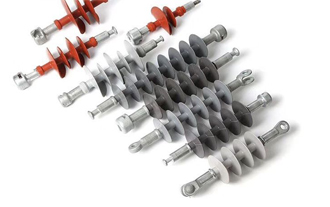Power Line Fittings supplier shares this article for you.
The performance of the line insulator directly affects the reliability and economy of operation of transmission lines, especially EHV transmission lines. Therefore, how to evaluate the reliability of EHV transmission insulators has become a particular concern of the power sector and insulator manufacturing sector.
There are three kinds of material insulators currently used on overhead transmission lines-porcelain insulators, glass insulators, and organic composite insulators. The current production status of China is mainly based on the production and use of porcelain insulators. The domestic production capacity of glass insulators only accounts for 20% of the total domestic insulator demand; the development of composite insulators in China started late, due to the recent domestic and foreign Progress is rapid, and production and usage have shown an upward trend.
1 Five criteria for reliability evaluation of composite insulators
The reliability of operation is the key to determine the vitality of insulators. * A good evaluation should be the performance level reflected by the statistical results of long-term operation of a large number of insulators on the transmission line and the reliability test. Therefore, the evaluation of insulators should follow the following guidelines:
(1) The life cycle of composite insulator
Composite Insulators can maintain its performance not less than the factory standard under the conditions specified in the standard. The minimum service life is "life cycle". This index not only reflects the safe use period of insulators but also reflects the economics of transmission line investment. my country has successively conducted tracking and comparison tests on the mechanical and electrical properties of glass and porcelain insulators that have been in operation for 5 to 30 years. The results show that the service life of glass insulators depends on metal accessories, and the service life of porcelain insulators depends on insulating parts. The life cycle of glass insulators can be up to 40 years, while the average life cycle of porcelain insulators is only 15 to 25 years, except for the full use of foreign manufacturing technology, the average life cycle is only 15 to 25 years; The development of the "three generations", but from the test and analysis of the operating results worldwide so far, the average life cycle is only 7 years.

Composite Insulators
(2) Failure rate
The ratio of the number of annual failure insulators in operation to the total number of operation insulators is called the annual failure rate. For domestic glass insulators, the average failure rate in the life cycle is (1~4)×10-4/a. For the failure rate of domestic porcelain insulators, except for individual joint venture products, it may be lower than that of glass insulators. 1 ~2 orders of magnitude; for composite insulators, the failure rate is difficult to predict because the life cycle cannot be predicted, the composite material formulation and manufacturing process cannot be completely finalized.
(3) Failure detection rate
Whether the detection rate of the insulator after the failure is detected has a greater impact on the safe operation of the line than the failure rate itself. The detection rate depends on the manifestation of the failure of the insulator and the cause of the failure. The manifestations of glass insulator failure are "auto-break" and "zero-value self-break". "Self-breaking" is not aging, but a form of failure of glass insulators, so it is easy to detect failed insulators by visual inspection, and the failure detection rate can reach 100%; the failure of porcelain insulators is the first form of failure The concealed "zero value" or "low value" is the main manifestation of composite insulator failure in the form of umbrella skirt erosion and concealed composite "interface breakdown". In addition, the cause of the failure of porcelain and composite insulators is the aging of the material, and the degree of aging is a function of time. Aging is hidden, so it brings great difficulties to the detection, resulting in a very low detection rate; for composite insulators, it is actually impossible to detect.
(4) Accident rate
The ratio of the number of annual disconnections to the number of operating insulators is called the annual accident rate. Loss of insulators is one of the serious accidents of overhead transmission lines. For EHV transmission, if a large-scale, long-term power outage is caused, the consequences will be unimaginable.
The operation experience of domestic glass insulators in the past 30 years proves that on 220-500kV transmission lines, there has never been a disconnection accident due to the failure of glass insulators, and the failure rate of domestic porcelain insulators is as high as 2×10-5. Studies in the former Soviet Union point out that even if the failure rate is the same, the accident rate of porcelain insulators is at least an order of magnitude higher than that of glass insulators. Since the composite insulator is a long rod type, the accident of disconnection generally seldom occurs, but the factors that lead to the breakdown of the inner insulation, the breakage of the core rod, and the decrease in strength always exist. Once it fails, the probability of the accident will be higher than the insulator string composed of multiple components.
(5) Reliability test of insulator
In order to evaluate the reliability of insulators, glass insulators and porcelain insulators have been subjected to various accelerated life tests and forced aging tests at home and abroad. Such as: steep wave test, heat engine test, arc resistance test, 15 million low-frequency (18.5 Hz) and 2 million high-frequency (185-200 Hz) vibration fatigue tests and internal water pressure tests, all drawn conclusions from different angles: In contrast to glass insulators, most porcelain insulators fail these tests. For composite insulators, reliability testing is still a subject to be explored.
+86 319 878 9350
+86 156 1304 7999
+86 319 878 9350
NanYan, DongHuan Road, Shahe, Hebei China
Copyright © Hebei Yipeng Line Equipment Co., Ltd. All Rights Reserved. | Sitemap Powered By 
